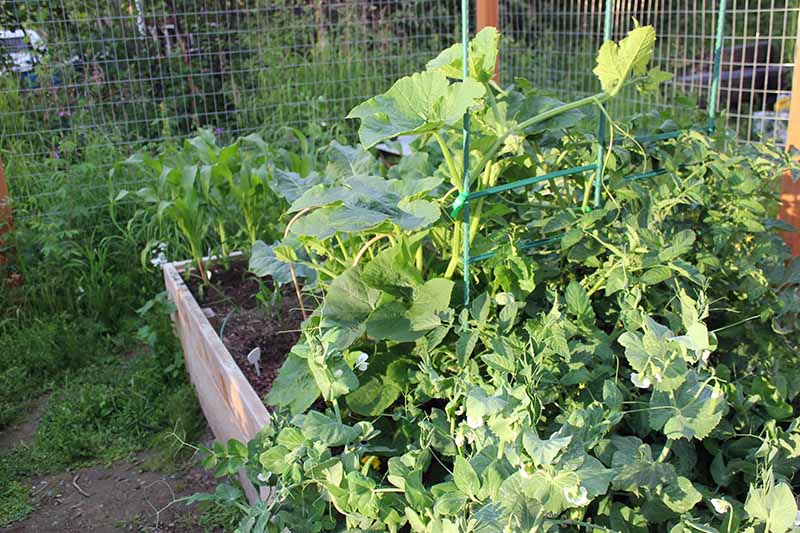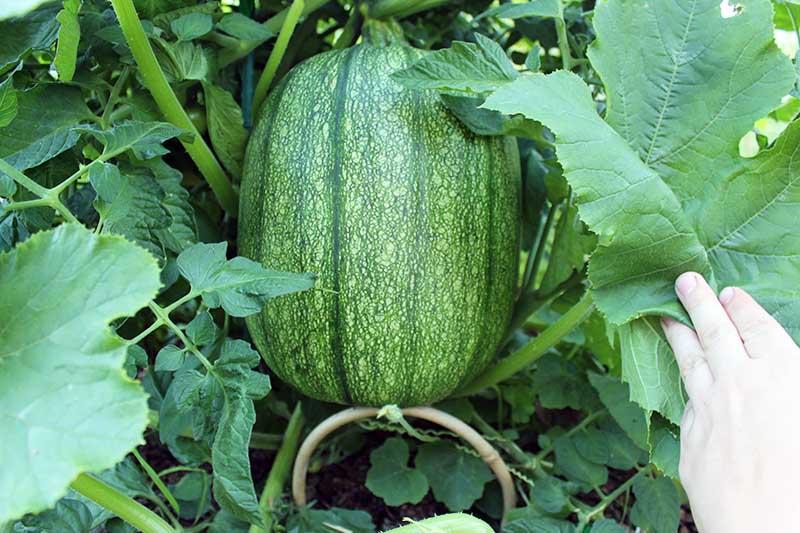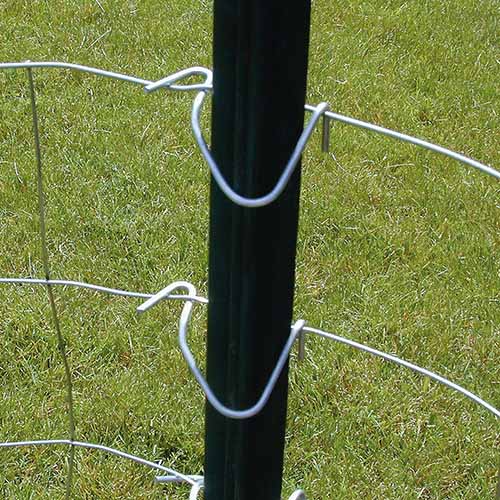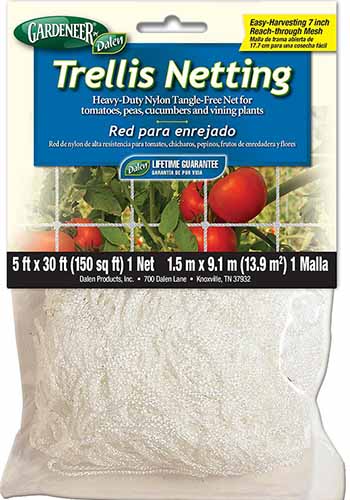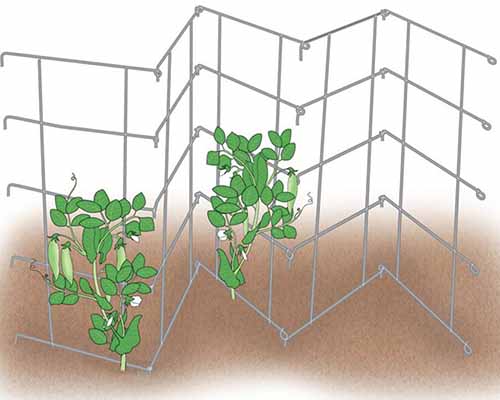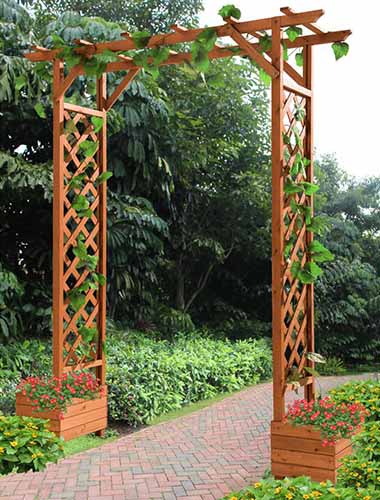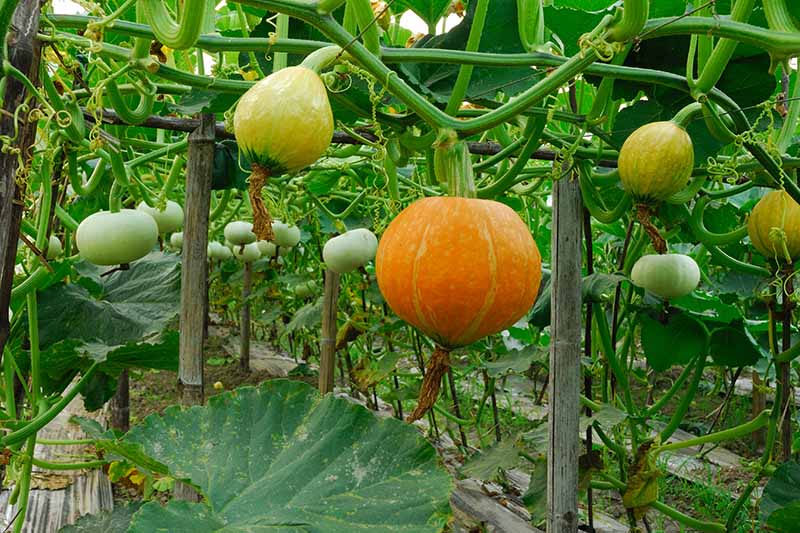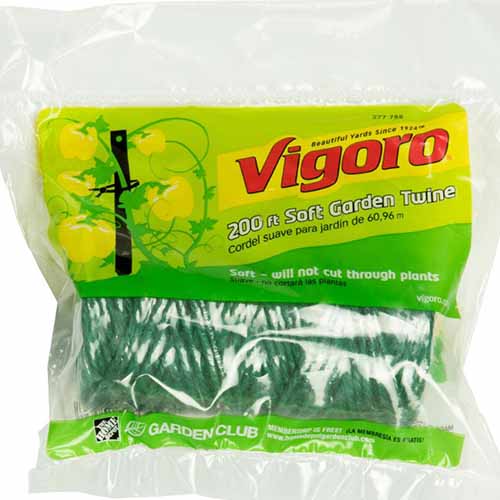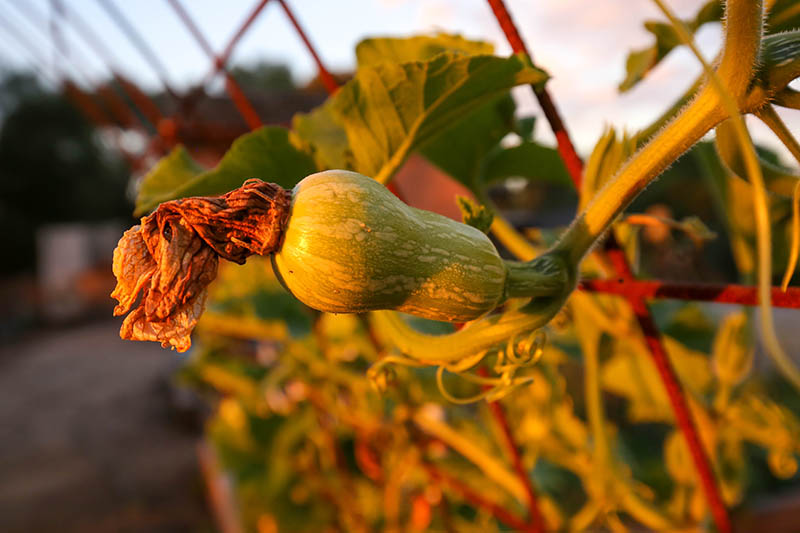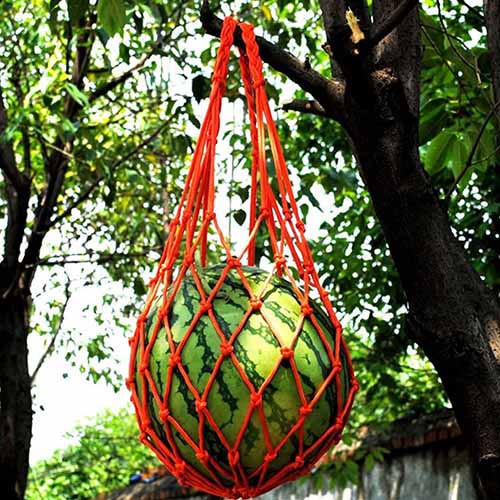I’d never grown the Cucurbits before, and I figured the vines would curl neatly around the tiny bamboo hoops and produce precious, delicate gourds. If you have ever grown pumpkins, you know how wrong this is. At first, the attractive hoops did the job just fine. The young vines grew slowly. I fastened them to the hoops with gardening ties and smiled at their gentle beauty. We link to vendors to help you find relevant products. If you buy from one of our links, we may earn a commission. It had essentially railed against the tiny bamboo hoop and demanded a better trellis. I responded by giving it some space on the tomato fence and apologizing for my rookie mistake. If you want to train your pumpkins on a trellis but don’t know where to start, we’ve got you covered. Here’s what I’ll go over in this article:
Why Should I Grow Pumpkins Vertically?
Somewhere in all my research about growing these members of the Cucurbitaceae family, I glossed over the well-documented fact that your average pumpkin vine can grow to anywhere from 10 to 20 feet in length. Because of that, I ended up having to force my tomatoes to share a plastic trellis with my ‘Howden’ vines, because you can’t even see the little bamboo hoop that I initially installed anymore. The vines and leaves have consumed it entirely. Even though my plant is being supported by a tomato trellis, the gourds are growing wonderfully. Perhaps too wonderfully! One of my ‘Howden’ fruits is larger than my head. It may just break the plastic trellis when it gets even larger – if I were to leave it without additional support, that is, which we’ll talk more about in a moment. But at least it’s not resting on the soil, potentially getting soggy and bug-infested. Let me tell you the story of how I fell in love with vertical gardening for vining plants. I planted peas this year that supposedly didn’t need any support in order to grow. They grew long and lovely in my raised bed, producing white blooms from which spilled fat green pods. And then the vines grew so long that some of the pods and leaves dragged in the dirt. Not the gardening soil in the raised bed, but the regular old earth below it. Guess who found them down there? Slugs. The squishy beasts gnawed holes in the leaves and even in some of the pods. When I cracked one infested pod open, the peas were all slimy and rotted away. Every single pea vine that found a way to climb onto the adjacent tomato vines, on the other hand, stayed slug- and disease-free. That’s the huge draw of growing gourds on a trellis as well: the vines, leaves, and fruits all benefit from better airflow and fewer visits from pests, and therefore less disease and rot. Another benefit? If you have a small gardening area, you can actually grow pumpkins without worrying about the plant taking over the entire space.
What Type of Trellis Should I Choose?
Before we get into the nitty-gritty of successfully training your pumpkin to grow on a trellis, let’s figure out which type will work best for you.
DIY Trellis
If you’re handy with wood and want to fashion your own trellis, go for it! It would look utterly fantastic as the entrance to any garden or yard. Plus, this arch can support your heavier gourds: ‘Howden,’ ‘Musquee de Provence,’ and ‘Jack-O-Lantern,’ to name a few.
Steel T Post, available at Home Depot Try these 7-foot-tall posts from the Home Depot.
Then get this five-foot-wide, 30-foot-tall nylon netting from Home Depot and use heavy-duty scissors to cut it down to five feet wide by six feet tall. Fasten the netting to the posts with these zip ties. If you have a classic, ground-level garden, erect this structure wherever you plan to grow your gourds. For raised bed gardeners, you’ll want to put it in the ground behind the raised bed box so that you can grow pumpkins in the bed and train them onto the adjacent trellis. Or, grow your gourds in containers and put the trellis anywhere you want! This type of structure works best for small and medium-sized pumpkins and other types of gourds.
Pea Fence
For a structure that’s nice and tall – eight feet, to be exact – try a pea fence, like this one from the Home Depot.
Pea Support Fence This foldable panel trellis works well for smaller pumpkin varieties, but you can also use it for medium gourds, like ‘Triple Treat’ and ‘Jarrahdale.’ Read more about our favorite pumpkin cultivars for cooking.
Tomato Cage
I learned from training my cantaloupe vine that a tomato cage makes an excellent trellis. You’ve got to find a tall one, though.
54-inch Tomato Cage This 54-inch cage from the Home Depot would work well for smaller varieties. Think ‘Jack be Little,’ ‘Small Sugar,’ and ‘Orange Smoothie.’ Read more about our favorite pumpkin cultivars for decorating.
Trellised Arbor
For an enchanting arch of strong, vibrant vines, try this delightful arbor from the Home Depot.
Sunjoy Wood Arbor Soaring to a height of 82 inches (nearly seven feet!) and measuring 23 inches wide, this is my dream pumpkin-growing structure. It features a growing box on each side, making it easy for you to plant a gourd and train the vines to grow through the latticework on the sides of the arbor. To check out the best pumpkin varieties for pie, read more.
Training Young Plants to the Structure
While our full guide to growing pumpkins covers the details of sowing and growing the large Cucurbits, I’ll briefly address how to plant them with the intention of growing them vertically here. You can grow pumpkins in USDA Hardiness Zones 3-9.
If you live in Zone 7 and up, go ahead and direct sow your seeds in one-inch holes right next to your trellis, and then cover lightly with soil. The ideal time to do this is after the last average frost date, when there’s no threat of more freezing weather in the forecast. Keep seeds moist until germination, which should occur within five to 10 days. As soon as the true leaves emerge and little vines get tall enough to reach your structure, they’re ready for training. If you live in Zones 3-6, you’ll probably need to sow seeds indoors in biodegradable peat pots. When they’ve got two to three true leaves, transplant them outdoors by making a hole in the earth that’s about the size of your pot and placing it inside. Just make sure to plant the peat pot next to the trellis, and keep it nice and moist. The same rule goes for those of you who buy young plants from a nursery: dig a hole as deep and wide as the pot, remove the plant, and put it in the hole. Backfill with soil and water thoroughly. When you have young, slightly floppy little vines, it’s time to act.
Vigoro Soft Garden Twine Get out your gardening ties or twine, like this product from the Home Depot, and loosely tie the main vine to your trellis. If it’s still floppy, add another piece of twine further along the vine. Just make sure you don’t tie it too tight. You want the vine to have plenty of room to breathe and grow. For those lucky souls growing vines on a lattice, simply begin weaving the young vine through. You probably won’t need any twine at all! The design of a lattice naturally holds the vine in place. The same applies if you’re training the vine on nylon netting, which acts like a lattice. But if you’re in doubt, or if your vine seems unstable or keeps falling out of place, go ahead and use some twine to secure it.
Now, the next step is important: you must check on the vine every day. Not only will this help you monitor for pests and disease, it’ll also show you where you need to keep training the vine. Add twine where you need to and keep it growing vertically. If you don’t, the vine will get long, tangly, and droopy, making it harder for you to retrain it. By keeping everything tidy, you give the flowers space to grow and the bees will have room to land on them. Or, you can hand pollinate them – see our guide to hand pollinating pumpkins for details on that.
Supporting the Fruit
Wouldn’t it be sad to have spent all that time training the vines on a structure, only to have the fruits break off because the vine can’t support their hanging weight? View Post Net Slings for Pumpkins Affix the sling to the trellis, and voila! Your vine won’t collapse under the weight of its heavy fruit. I didn’t have any slings on hand by the time my ‘Howden’ grew to enormous proportions, so I stuck one of those tiny bamboo hoops under it to give the vine some relief. Use whatever you have on hand, or order those slings! This is what I’ll be doing for next season’s vertical pumpkin-growing efforts.
Delightfully Docile
Now you know that you can tame your sprawling vine by teaching it how to grow upwards, you don’t have to worry about it choking out all the other plants in your garden.
Tell me, have you ever grown a pumpkin vertically? I’d love to know your story. And if you have any questions or comments, ask away! And check out these pumpkin growing articles next, for more tutorials and useful information:
5 Reasons Why Your Pumpkin Isn’t Producing Fruit Best Companion Plants to Grow with Pumpkins How to Grow Giant Pumpkins How Do I Know When My Pumpkin Is Ripe? Picking and Harvest Tips


